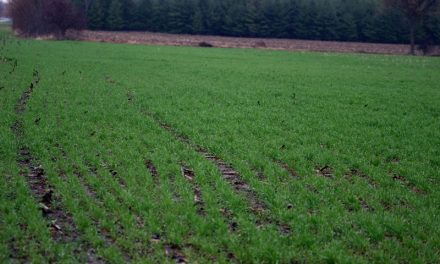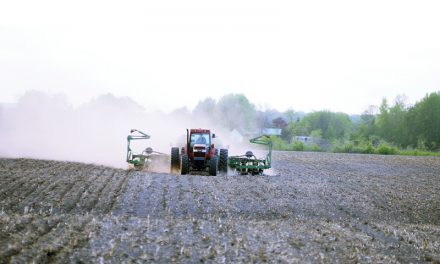Protecting young trees
South Nation Conservation’s Senior Forestry Technician Chris Craig explains the purpose of the cylinder-shaped devices – the cocomats– to visitors at the tree planting demo site in Bourget, on the SNC’s annual bus tour last month. Carruthers photo

Nothing in the actual drain was planted by South Nation Conservation. What was actually growing, the southern wild rice, within that drain showed just how healthy the waterway was.
Carruthers photo
BOURGET – During the 16th annual South Nation Conservation Watershed Bus Tour, Senior Forest Technician Chris Craig discussed alternative cash possibilities for farmers. This includes South Nation Conservation going in to clear a portion along the crop area and plant fruit-bearing or nut trees, that would bring the farmer fruit or nuts in a few years to harvest, keep, use or sell. the conservation will work with the farmer to collect seeds from the plantings for use in other areas.
“For this project, it was beneficial. We approached the landowners to find out if they would be interested in doing this,” said Chris Craig. “It was a long waterway because the funding from Environment Canada was very specific. So, the proposal we wrote, one of the ideas that we would bring up was protecting water, that’s why this was for waterways.”
Whether it was a river, creek or any body of water, it was just about trying to protect that water from different sediment controls.
“It would be about keeping different sediment back from entering the water course,” said Craig. “Also nutrients and phosphorous loading from the land into the watercourse.”
When Craig approaches any farmer, he makes sure to lay out all of the benefits that come from the use of different seeds and new techniques including a five metre buffer from the field crop to the ditch. When looking at different avenues of seeds to plant at the waterway, certain conditions were checked including the revenue and food source.
“When I approach the farmer, what I would do is talk about what the benefits of the project were and, the fact that they wouldn’t be able to farm that five metre buffer,” he said. “So, for them to not lose financial from that five metre buffer, it was to show them the benefits from what they would gain in the long run through better nutrients being held back in the soils and that this five metre buffer would help with temperature and climate change in their farm areas.”
“We also looked at tree species and the plant species on generating either a revenue or a food source for the family,” he added. “So, there was something they could get out of this five metre buffer.”
It is not necessary for the farmers to share the seeds if they do not wish to; it is simply an opportunity for them to do so, showing a marketplace out there for the different planted seeds. A large variety of tree seeds were planted to produce a food source to create a new market for producing food that is naturally from the local area.
“We looked at different nut trees. We looked at the different trees and shrubs that could produce a food source in the nut field because of the fact that the different nuts that are a market that are coming back; it’s a new market for producing food from these nuts that grow naturally from our area,” said Craig. “We used American hazelnut as one, we had black oak, white oak and red oak. We had swamp white oak – these are typical oaks that we would find here. Black oak not so much but with the temperature changing, black oak will be able to grow easier in this temperature.”
With climate change, the South Nation Conservation is simply looking to help those tree species migrate further north from their warmer climates to where the colder climates are, simply trying to speed the process of nature that nature does itself.
However, nothing in the actual drain was planted by South Nation Conservation. What was actually growing within the drain excited Craig because it showed just how healthy the waterway was.
“We didn’t actually plant anything right in the drain, that’s all natural,” said Craig. “The stuff that was growing in there is wild rice, the southern wild rice. Those were traditional foods that we looked at. It was a very important food staple for us. To see it growing, that really tells us that waterway is very healthy.”
Other tree types planted included maple trees because the maple syrup industry in Ontario used to be a large part of the farming industry. Three different maple species were planted, one that was bred genetically because of the sugar contents, which start higher in the sap. The others planted were black and sugar maple.
Different varieties of fruit trees were also planted, including apples, pears and the native plum species, raspberries, black raspberries, strawberries, and much more.
“We didn’t just plant one type of apple species, we planted five different types that are more of a variety,” said Craig. “If you plant only one species, you have to do a lot more maintenance to maintain a healthier creek. If you do a variety, it’s much smaller to deal with.”
Farmers are able to do with the harvest as they wish, whether it’d be for personal use or selling for profit.
“It’s giving that opportunity to the farmer to see what they want to do with it,” said Craig. “The grass seed that we planted, it’s up to the farmer if they want to have that seed processed and we can find someone to process it.”
In these case, the processor will purchase the seed from the farmer, much like leasing out a field of corn where someone comes in and harvests it for you, processes it and then pays you for the value of that crop. They can then resell it to whomever they wish.
To help with the planting, a special device called a “cocomat” is used to help with the maintenance of the plant.”
“When they get wet, they push down and they hold the moisture in the soil for the seedlings to keep a good moisture content, plus it helps to keep the weeds away from that tree which would be using up more of the nutrients in water for the plant,” said Craig. “So, it helps the maintenance of the plant.”













